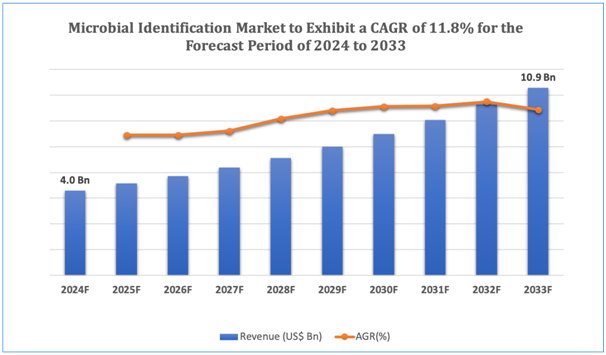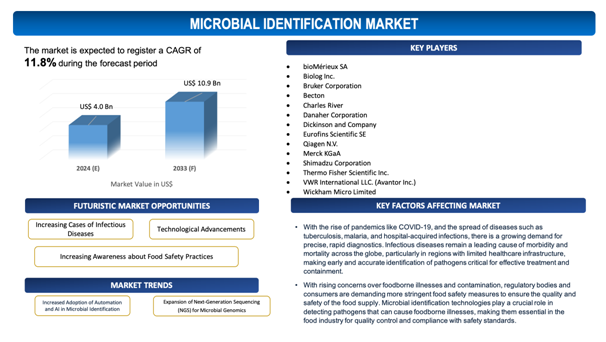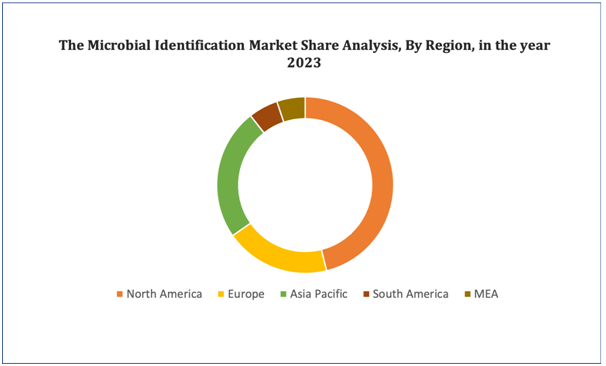Microbial IdentificationMarket Overview
The global microbial identification market is estimated to be worth over USD 10.9Bn in 2033 and is expected to grow at CAGR of11.8% during the forecast period (2024-2033).
Microbial identification is transforming the healthcare outlook by allowing precise detection, classification, and understanding of microorganisms, comprising bacteria, viruses, fungi, and parasites. This procedure is crucial in diagnosing infectious diseases, guiding appropriate treatments, and monitoring the spread of pathogens. Conventionally, microbial identification relied on time-consuming culture methods, but advances in technology have transformed it into a more accurate, efficient, and swift process, benefiting patient outcomes and public health.
One of the most notable impacts of microbial identification is its role in battling antimicrobial resistance (AMR). The capability to precisely identify pathogens at an early stage allows for targeted therapies, reducing the misuse of antibiotics and other antimicrobial drugs. This is crucial in preventing the development of resistant strains, which pose a global threat to healthcare systems. By determining the specific microbe responsible for an infection, healthcare providers can select the most effective treatment, avoiding broad-spectrum antibiotics that contribute to resistance.
Technological developments, such as mass spectrometry, polymerase chain reaction (PCR), and next-generation sequencing (NGS), have greatly enhanced the speed and precision of microbial identification. These technologies enable for real-time pathogen detection, allowing quicker diagnoses in critical care situations, such as sepsis or outbreaks of infectious diseases. For instance, PCR can detect specific genetic markers of pathogens in a matter of hours, while NGS can sequence entire microbial genomes, offering a comprehensive analysis of the microorganism's characteristics.
In addition, microbial identification holds a critical role in hospital infection control and epidemiology. It aids in tracking the source and spread of infectious diseases within healthcare facilities and communities, allowing for timely interventions and containment strategies. In the context of public health, microbial identification is essential in managing outbreaks of diseases such as COVID-19, influenza, and foodborne illnesses, offeringsignificant data for decision-making and response planning.
In conclusion, microbial identification is revolutionizing healthcare by providing rapid, accurate insights into infections, enhancing patient care, and contributing to global efforts in combating infectious diseases and antimicrobial resistance. As technology continues to advance, its role in diagnostics, treatment optimization, and public health management will only grow in significance.
Figure 1. Microbial Identification: Market Size

Get more details on this report - Request Free Sample
Key Market Insights
The global microbial identification market is experiencingrobust growth, driven by rising demand for accurate, rapid diagnostics in the face of increasing infectious disease outbreaks and antimicrobial resistance. Healthcare providers and pharmaceutical companies are focusing on more precise microbial identification to optimize treatment strategies, reduce the misuse of antibiotics, and improve patient outcomes. As a result, the market is witnessing widespread adoption of advanced technologies that enhance both accuracy and speed in identifying pathogens.
Latest developments in the market comprise the incorporation of next-generation sequencing (NGS), polymerase chain reaction (PCR), and mass spectrometry-based technologies such as MALDI-TOF (Matrix-Assisted Laser Desorption Ionization-Time of Flight). These advancements have substantiallyminimized the time required for microbial identification, enabling real-time pathogen detection and diagnosis. NGS, for example, provides comprehensive genomic information, enabling for the detection of previously unidentified or hard-to-culture microorganisms, while MALDI-TOF offers fast, accurate mass spectrometry analysis, now widely used in clinical microbiology.
The growing adoption of automation in microbial identification processes is another key trend, streamlining workflows in laboratories and enhancing throughput. Moreover, the soaring awareness of antimicrobial resistance has prompted investments in faster diagnostic tools, further accelerating market expansion.
Overall, the microbial identification market is poised for continued growth as technological advancements, the rise in infectious diseases, and global efforts to combat antimicrobial resistance drive demand for more efficient and precise diagnostic tools. The market’s continuous innovations in rapid, real-time pathogen detection technologies are reshaping the landscape of microbial diagnostics.
Market Dynamics
Market Drivers
Increasing Cases of Infectious Diseases
The increasing cases of infectious diseases globally serve as a significant driver for the growth of the microbial identification market. With the rise of pandemics like COVID-19, and the spread of diseases such as tuberculosis, malaria, and hospital-acquired infections, there is a growing demand for precise, rapid diagnostics. Infectious diseases remain a leading cause of morbidity and mortality across the globe, particularly in regions with limited healthcare infrastructure, making early and accurate identification of pathogens critical for effective treatment and containment.
Microbial identification technologies, such as polymerase chain reaction (PCR), next-generation sequencing (NGS), and mass spectrometry (MALDI-TOF), are becoming essential tools in diagnosing these infections swiftly and accurately. The ability to detect specific pathogens in real-time allows healthcare providers to administer appropriate treatments earlier, improving patient outcomes and reducing the spread of infections within communities and healthcare settings. This is particularly important in the case of antibiotic-resistant infections, where identifying the causative organism can prevent the overuse of broad-spectrum antibiotics and target the treatment precisely.
Moreover, the increasing global travel and interconnectedness have facilitated the faster spread of infectious diseases, further focusing on the need for rapid microbial identification to manage outbreaks and prevent pandemics. As the strain of infectious diseases continues to surge, the microbial identification market is estimated to expand, accelerated by the need for advanced diagnostic technologies that can deliver accurate results quickly to battle the spread and impact of infections.
Market Restraints
With regard to numerous advantages of Microbial Identification, the market faces several challenges due to the unique characteristics and requirements associated with these potent pharmaceutical products. Some of the key market challenges include:
- High Cost of Advanced Diagnostic Technologies: The implementation of cutting-edge microbial identification tools, such as next-generation sequencing (NGS) and mass spectrometry (MALDI-TOF), involves high initial costs and maintenance expenses. This restricts the adoption of these technologies, particularly in low-resource settings and developing regions, where healthcare budgets may be limited.
- Lack of Skilled Personnel: The use of sophisticated microbial identification systems requires trained professionals to operate and interpret results accurately. A shortage of skilled personnel, especially in developing countries and rural areas, can limit the effective utilization of advanced diagnostic technologies, hindering market growth.

Get more details on this report - Request Free Sample
Market Opportunity
IncreasingAwareness about Food Safety Practices
The increasing awareness about food safety practices presents a significant market opportunity for the global microbial identification market. With rising concerns over foodborne illnesses and contamination, regulatory bodies and consumers are demanding more stringent food safety measures to ensure the quality and safety of the food supply. Microbial identification technologies play a crucial role in detecting pathogens that can cause foodborne illnesses, making them essential in the food industry for quality control and compliance with safety standards.
Governments across the globe are tightening regulations on food safety, requiring manufacturers to implement rigorous testing protocols throughout the production process. The Food Safety Modernization Act (FSMA) in the U.S. and similar initiatives in other regions have heightened the need for reliable microbial identification solutions to monitor and control contamination risks. This regulatory push has fuelled food manufacturers and processors to invest in advanced technologies like PCR-based diagnostics, mass spectrometry, and next-generation sequencing (NGS) to ensure rapid and accurate pathogen detection.
In addition, as consumers become more conscious of the safety and quality of their food, there is growing demand for transparency and accountability in the food supply chain. The ability to quickly identify and trace microbial contaminants helps companies mitigate the risk of outbreaks, recalls, and reputational damage, further driving the adoption of microbial identification tools in the food sector.
This rising emphasis on food safety offers a significant growth opportunity for the microbial identification market, particularly in the food and beverage industry.
Market Trends
- Increased Adoption of Automation and AI in Microbial Identification: There is a growing trend towards the integration of automation and artificial intelligence (AI) in microbial identification processes. Automated systems enhance the accuracy, speed, and efficiency of pathogen detection, while AI-driven tools can analyse vast amounts of microbial data, improving diagnostics and enabling predictive modelling for outbreaks.
- Expansion of Next-Generation Sequencing (NGS) for Microbial Genomics: The adoption of next-generation sequencing (NGS) technologies is on the rise, offering comprehensive insights into microbial genomes. NGS enables the identification of complex microbial communities, including previously unculturable organisms, and provides deeper understanding for infection control, epidemiology, and the development of targeted treatments, driving innovation in microbial diagnostics.
Microbial Identification Market: Key Segments
By Product & Services
- Instruments
- Mass Spectrometers
- PCR Systems
- Microarrays
- Others
- Consumables
- Reagents & Kits
- Plates & Media
- Software & Services
- Identification Services
- Culture Collection Services
- Assay Validation Services
By Technology
- Mass Spectrometry
- PCR
- Microarrays
- Next Generation Sequencing
- Others
By Method
- Phenotypic Methods
- Genotypic Methods
- Proteotypic Methods
By Application
- Clinical Diagnostics
- Pharmaceuticals
- Food & Beverage Testing
- Environmental Application
- Others
By End-Use
- Pharmaceutical and Biotechnology Companies
- Hospitals and Diagnostic Laboratories
- Food Testing Laboratories
- Others
By Key Geographical Regions
- North America
- Europe
- Asia-Pacific
- Middle East and Africa
- South America
Figure 4. Microbial Identification Market: Distribution by Region

Get more details on this report - Request Free Sample
Microbial Identification Market: Regional Analysis
North America microbial identification market accounted for the largest market share of 38.25% in 2023. This is attributed to the increasing prevalence of infectious diseases, presence of key market players, and well-established healthcare infrastructure. In January 2022, BD has secured FDA 510(k) clearance for the BD Kiestra IdentifA system, an automated platform specifically engineered to streamline the microbiology bacterial identification testing sample preparation process.
Leading Microbial Identification Developers
Industry Trends and Global Forecasts, 2023-2035 report features an extensive study of the current market landscape, market size and future opportunities associated with the Microbial Identificationmarket, during the given forecast period. Further, the market report highlights the efforts of several stakeholders engaged in this rapidly emerging segment of the biopharmaceutical industry. Key takeaways of the Microbial Identificationmarket are briefly discussed below.
The report includes the list of players operating in the global Microbial Identificationmarket. Some of the key players include:
- bioMérieux SA
- Biolog Inc.
- Bruker Corporation
- Becton
- Charles River
- Danaher Corporation
- Dickinson and Company
- Eurofins Scientific SE
- Qiagen N.V.
- Merck KGaA
- Shimadzu Corporation
- Thermo Fisher Scientific Inc.
- VWR International LLC. (Avantor Inc.)
- Wickham Micro Limited
Microbial Identification Market: Key Developments
- In November 2023, QIAGEN has introduced a comprehensive Sample to Insight workflow tailored for microbiome research which is anticipated to accelerate research workflow which include whole genome metagenomics library preparation, DNA extraction kits, and bioinformatics analysis.
Scope of the Report
The market report presents an in-depth analysis of the various firms / organizations that are engaged in this market, across different segments, as defined in the below table:
|
|
Key Report Attributes |
Details |
||
|
|
Base Year |
2023 |
||
|
|
Forecast Period |
2024-2033 |
||
|
|
CAGR (2024-2033) |
11.8% |
||
|
|
Products & Services |
|
||
|
|
Technology |
|
||
|
|
Method |
|
||
|
|
Application |
|
||
|
|
End-Use |
|
||
|
|
Key Geographical Regions |
|
||
|
Key Companies Profiled |
|
|
||
